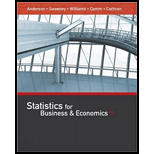
Concept explainers
Rating Wines from the Piedmont Region of Italy
Wine Spectator magazine contains articles and reviews on every aspect of the wine industry, including ratings of wine from around the world. In a recent issue they reviewed and scored 475 wines from the Piedmont region of Italy using a 100-point scale (Wine Spectator, April 30, 2011). The following table shows how the Wine Spectator score each wine received is used to rate each wine as being classic, outstanding, very good, good, mediocre, or not recommended.
| Score | Rating |
| 95–100 | Classic: a great wine |
| 90–94 | Outstanding: a wine of superior character and style |
| 85–89 | Very good: a wine with special qualities |
| 80–84 | Good: a solid, well-made wine |
| 75–79 | Mediocre: a drinkable wine that may have minor flaws |
| below 75 | Not Recommended |
A key question for most consumers is whether paying more for a bottle of wine will result in a better wine. To investigate this question for wines from the Piedmont region we selected a random sample of 100 of the 475 wines that Wine Spectator reviewed. The data, contained in the file named WineRatings, shows the price ($), the Wine Spectator score, and the rating for each wine.
Managerial Report
- 1. Develop a table that shows the number of wines that were classified as classic, outstanding, very good, good, mediocre, and not recommended and the average price. Does there appear to be any relationship between the price of the wine and the Wine Spectator rating? Are there any other aspects of your initial summary of the data that stand out?
- 2. Develop a
scatter diagram with price on the horizontal axis and the Wine Spectator score on the vertical axis. Does the relationship between price and score appear to be linear? - 3. Using linear regression, develop an estimated regression equation that can be used to predict the score given the price of the wine.
- 4. Using a second-order model, develop an estimated regression equation that can be used to predict the score given the price of the wine.
- 5. Compare the results from fitting a linear model and fitting a second-order model.
- 6. As an alternative to fitting a second-order model, fit a model using the natural logarithm of price as the independent variable. Compare the results with the second-order model.
- 7. Based upon your analysis, would you say that spending more for a bottle of wine will provide a better wine?
- 8. Suppose that you want to spend a maximum of $30 for a bottle of wine. In this case, will spending closer to your upper limit for price result in a better wine than a much lower price?
Trending nowThis is a popular solution!

Chapter 16 Solutions
Statistics for Business & Economics
- Let X be a random variable with support SX = {−3, 0.5, 3, −2.5, 3.5}. Part ofits probability mass function (PMF) is given bypX(−3) = 0.15, pX(−2.5) = 0.3, pX(3) = 0.2, pX(3.5) = 0.15.(a) Find pX(0.5).(b) Find the cumulative distribution function (CDF), FX(x), of X.1(c) Sketch the graph of FX(x).arrow_forwardA well-known company predominantly makes flat pack furniture for students. Variability with the automated machinery means the wood components are cut with a standard deviation in length of 0.45 mm. After they are cut the components are measured. If their length is more than 1.2 mm from the required length, the components are rejected. a) Calculate the percentage of components that get rejected. b) In a manufacturing run of 1000 units, how many are expected to be rejected? c) The company wishes to install more accurate equipment in order to reduce the rejection rate by one-half, using the same ±1.2mm rejection criterion. Calculate the maximum acceptable standard deviation of the new process.arrow_forward5. Let X and Y be independent random variables and let the superscripts denote symmetrization (recall Sect. 3.6). Show that (X + Y) X+ys.arrow_forward
- 8. Suppose that the moments of the random variable X are constant, that is, suppose that EX" =c for all n ≥ 1, for some constant c. Find the distribution of X.arrow_forward9. The concentration function of a random variable X is defined as Qx(h) = sup P(x ≤ X ≤x+h), h>0. Show that, if X and Y are independent random variables, then Qx+y (h) min{Qx(h). Qr (h)).arrow_forward10. Prove that, if (t)=1+0(12) as asf->> O is a characteristic function, then p = 1.arrow_forward
- 9. The concentration function of a random variable X is defined as Qx(h) sup P(x ≤x≤x+h), h>0. (b) Is it true that Qx(ah) =aQx (h)?arrow_forward3. Let X1, X2,..., X, be independent, Exp(1)-distributed random variables, and set V₁₁ = max Xk and W₁ = X₁+x+x+ Isk≤narrow_forward7. Consider the function (t)=(1+|t|)e, ER. (a) Prove that is a characteristic function. (b) Prove that the corresponding distribution is absolutely continuous. (c) Prove, departing from itself, that the distribution has finite mean and variance. (d) Prove, without computation, that the mean equals 0. (e) Compute the density.arrow_forward
- 1. Show, by using characteristic, or moment generating functions, that if fx(x) = ½ex, -∞0 < x < ∞, then XY₁ - Y2, where Y₁ and Y2 are independent, exponentially distributed random variables.arrow_forward1. Show, by using characteristic, or moment generating functions, that if 1 fx(x): x) = ½exarrow_forward1990) 02-02 50% mesob berceus +7 What's the probability of getting more than 1 head on 10 flips of a fair coin?arrow_forward
 Glencoe Algebra 1, Student Edition, 9780079039897...AlgebraISBN:9780079039897Author:CarterPublisher:McGraw Hill
Glencoe Algebra 1, Student Edition, 9780079039897...AlgebraISBN:9780079039897Author:CarterPublisher:McGraw Hill Big Ideas Math A Bridge To Success Algebra 1: Stu...AlgebraISBN:9781680331141Author:HOUGHTON MIFFLIN HARCOURTPublisher:Houghton Mifflin Harcourt
Big Ideas Math A Bridge To Success Algebra 1: Stu...AlgebraISBN:9781680331141Author:HOUGHTON MIFFLIN HARCOURTPublisher:Houghton Mifflin Harcourt Holt Mcdougal Larson Pre-algebra: Student Edition...AlgebraISBN:9780547587776Author:HOLT MCDOUGALPublisher:HOLT MCDOUGAL
Holt Mcdougal Larson Pre-algebra: Student Edition...AlgebraISBN:9780547587776Author:HOLT MCDOUGALPublisher:HOLT MCDOUGAL



